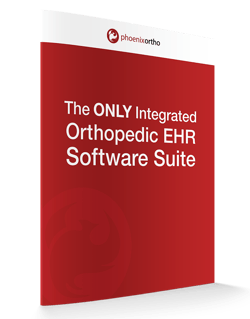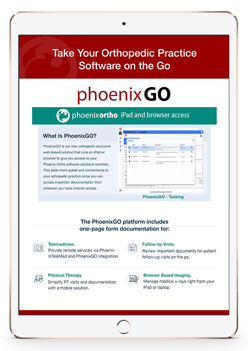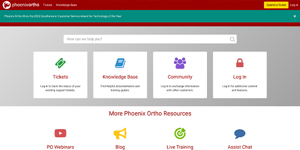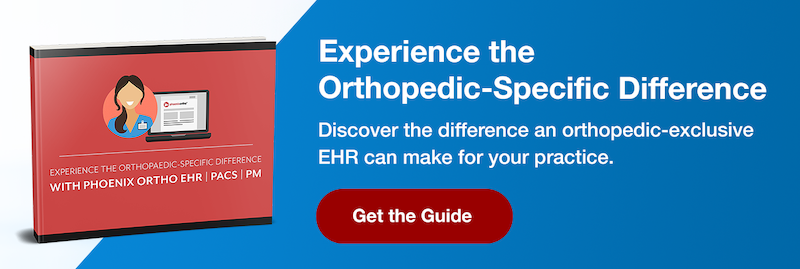In light of the COVID-19 pandemic, many healthcare providers (including orthopedic practices) turned to the use of virtual healthcare technologies to continue providing medical services while holding to epidemic containment best practices.
As noted in the background section of a study on digital orthopedics:
“The COVID-19 pandemic is placing a massive strain on the ability to deliver care to patients with musculoskeletal complaints. In the world of hip and knee arthroplasty, which generally cares for an older population with a number of comorbidities, patients are being asked to delay interventions until hospitals are safe for elective surgery.”
In other words, during the pandemic, the risk of infections was contributing to delays in care as patients had to put off any “non-emergency” care (even when said care would be vital for preserving mobility and quality of life).
Virtual healthcare solutions proved to be highly effective for helping orthopedists keep their businesses open in the face of social distancing requirements in the pandemic. Deloitte noted that during the pandemic, there was “an increase in consumer willingness to share data in every scenario measured.” This helped to make virtual patient visits (and remote healthcare in general) more viable.
In this article, we’ll discuss virtual healthcare, its benefits, and some tools that orthopedic clinics can use to improve their remote healthcare services.
What Is Virtual Healthcare?
If traditional healthcare is when a patient visits a doctor’s office for health consultations, treatments, and service scheduling, then virtual healthcare is when a patient and doctor “see” one another remotely via technology solutions.
It should be noted that while virtual healthcare uses telehealth software and other technologies, the two terms are distinct.
Telehealth technology covers the wide range of software and hardware solutions that are used to deliver remote orthopedic practice services. Some practices have even adapted non-healthcare technologies into their virtual visit processes. For example, a teleconferencing solution with video could be used to enable remote orthopedic care, which could make it usable as a makeshift telehealth software.
However, in practice, actual telehealth solutions are usually designed around healthcare interactions. These solutions are made to integrate into healthcare workflows to simplify documentation of patient visits in ways that more generic technologies don’t—helping to minimize the risk of misfiling important information.
The Benefits of Virtual Healthcare
So, how does virtual healthcare—and by extension, remote orthopedics—help orthopedic clinics and doctors? There are several benefits for doctors being able to see patients virtually with telehealth solutions, including:
1. Improving Patient Engagement with Healthcare Services
High patient engagement with healthcare can help orthopedic clinics ensure repeat business and improve patient outcomes (largely by encouraging patients to share more information and not missing important appointments).
Telehealth solutions that enable virtual healthcare help to improve patient engagement with care by removing basic barriers to seeking care. For example, instead of having to get in a car and drive to the clinic (or arranging transport if they are unable to drive due to injury or illness), a patient can use a telehealth app to conduct a virtual visit right away. This allows orthopedic surgeons to “see” and remotely consult with patients who otherwise might have avoided care.
If patients show or report indications of a severe injury or condition that requires in-person care, then the doctor can encourage the patient to make the trip.
2. Improving Patient Satisfaction
While closely related to patient engagement, patient satisfaction with their quality of care is not the same as how engaged they are with their care. Satisfaction is more of a measure of how happy the patient is about the services they’ve received where engagement is a measure of how involved the patient is in their care.
For example, it is possible for a patient who is very satisfied with their care to neglect following up on a doctor’s recommendations. Meanwhile, a patient who is engaged with their healthcare but unsatisfied with their treatment might look for a second opinion after a visit.
So, it’s important to drive both engagement and satisfaction at the same time. This way, patients will be more likely to return for more healthcare services in the future. Virtual visits can help drive patient satisfaction with care by increasing the convenience of care.
For example, instead of having to wait in the clinic’s lobby, patients can send off important information via a telehealth app and get on with their day until an orthopedic physician can send a reply.
3. Increasing the Number of Patients the Clinic Can Service
By removing the barrier of having to physically travel to the clinic for basic consultative services, virtual patient visits can allow a clinic to serve a larger area than they could with just traditional in-person healthcare.
Additionally, with virtual visits, orthopedists can save time on each visit—increasing the number of patients they can service each day.
Increasing the service area for the clinic and each surgeon’s capacity for patient visits can help contribute to an increase in the clinic’s earnings.
Top Tools to Streamline Virtual Healthcare Programs for Orthopedics
With an understanding of some of the basic benefits of adding virtual healthcare services to your clinic’s workflows, the next step is to investigate ways of integrating telehealth solutions with your practice. There are many healthcare technologies that an orthopedic practice can include to provide quality healthcare services. Here’s a short list of some of the top tools:
- Telemedicine Software and Apps. One of the most important tools for enabling remote orthopedic services is some form of telemedicine software. Having a solution for patients to record and send information about their condition for doctors to review later can be a major time-saver. Also, care providers can share important information with patients as well—such as exercise instructions, post-surgery care advice, and tips for taking certain medications. Patients can download and use the information after the virtual visit is completed.
- Mobile Prescription Solutions. Patients aren’t the only ones who might benefit from having an app on their phone! Mobile prescription management solutions, such as iPrescribe, make it much easier for orthopedic surgeons to submit, review, or sign off on prescriptions while on the go. This can make sending prescriptions faster so patients can get necessary medications sooner.
- Patient Charting Solutions. Being able to take all of a patient’s data from a telehealth solution and store it in a patient chart with the rest of their medical history data, prescription information, medical images, and visit reports can help orthopedists provide better, more comprehensive care. It can also help when determining the right evaluation and management (E & M) billing codes for virtual visits.
- Billing Solutions. Just because a visit is virtual doesn’t mean that billing becomes less important! It’s necessary for orthopedic practices to ensure that they can continue to collect revenue from their virtual visits. So, having an integrated billing solution that can help doctors review patient visit files, assign the right E & M codes, and then submit claims to payer organizations (such as health insurance companies) can be incredibly important. Having a system that can automate the process to reduce errors can help make collections even more efficient.
Are you ready to transform your practice to leverage virtual visits and telehealth technology? Request a demo of Phoenix Ortho today!
Schedule a 1:1
Get in touch with Phoenix Ortho to learn more about how you can save time, money, and mouse clicks with an orthopedic-specific EHR.






















